???????? ?????, ?????????
Download as pptx, pdf6 likes568 views
The Theory/Philosophy of Ayurveda Principles & Practice
1 of 25
Download to read offline
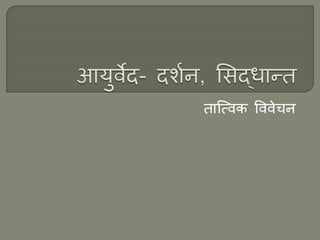
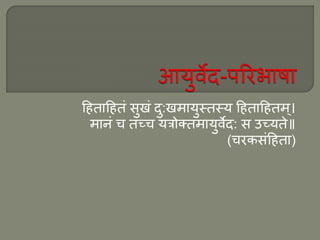
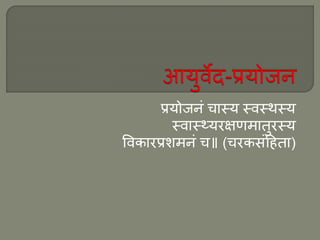

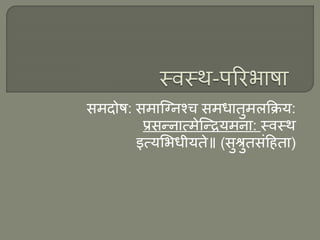
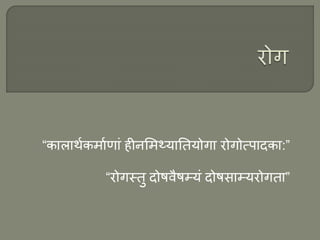
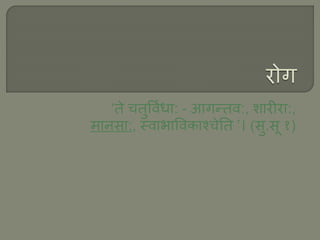
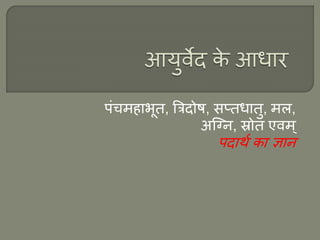

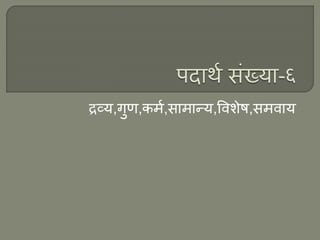
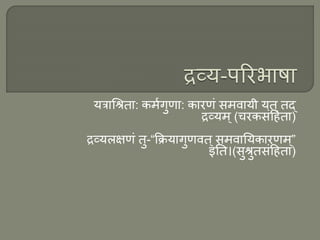
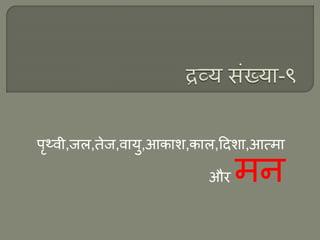
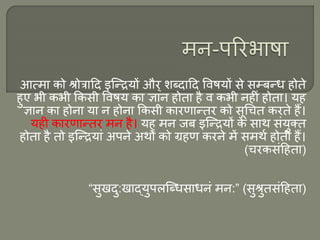
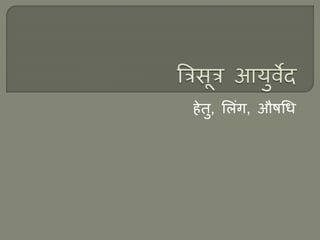
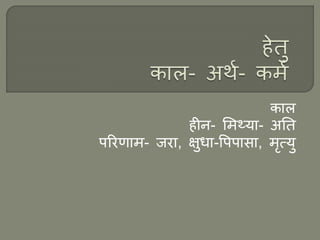
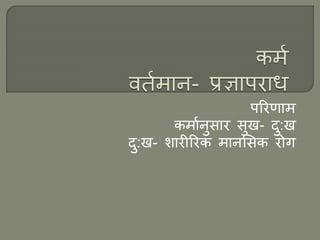
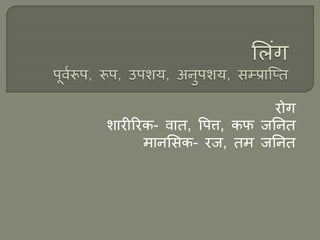

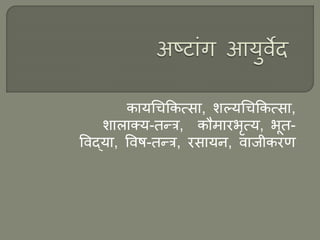

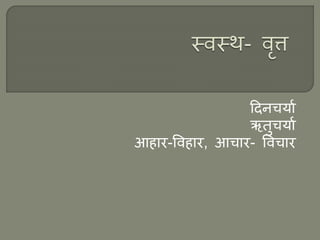
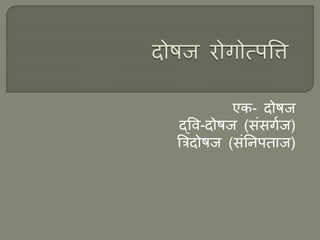
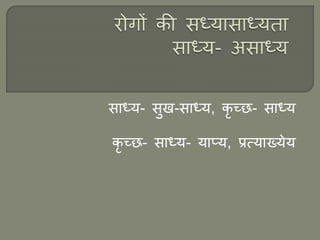

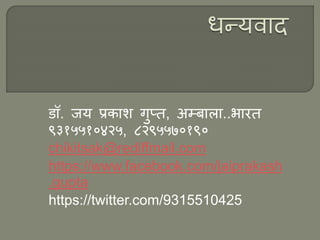
Ad
Recommended
FUNDAMENTAL CONCEPTS OF KAYACHIKITSA
FUNDAMENTAL CONCEPTS OF KAYACHIKITSADrSwati7
?
Definition of Kayachikitsa
Nirukti of Kaya
Fundamental concept of Kayachikitsa
Vriddhi and kshaya of Dosha
Vriddhi and kshaya of Dhatu
Vriddhi and kshaya of Mala
ROLE OF TRIVIDHA PAREEKSHA AND PRAMANA IN AYURVEDA
ROLE OF TRIVIDHA PAREEKSHA AND PRAMANA IN AYURVEDALolashri
?
AYURVEDIC METHOD OF BASIC CLINICAL EXAMINATIONEffect of asanas on human body systems
Effect of asanas on human body systemsvishwjit verma
?
A Assignment work For M.A( Human consciousness & yogic Science) 2nd Sem. On Effect of Asanas on Human Body systems eg. skeletal, muscular,digestive Nerves .Systems..etc. Yoga and total health
Yoga and total healthShivartha
?
Yoga is the science of life and the art of living. It is a common sense answer for overall physical and mental health. Basically, yoga is a system of physical and mental self-improvement and ultimate liberation, which people have been using for thousands of years. Yoga originated in the period of Vedas and Upanishads. It is the oldest scientific, best spiritual discipline of India. Yoga is a method of training the mind and developing the power of its subtle senses so that man can discover for himself the spiritual truth on which religions, beliefs and moral values ??ultimately rest. It is a confession of our hidden powers. Swami Sivananda said, "He who spreads good, divine thoughts is good for himself and also for the world." Yoga is the science of life, it guarantees us physical and mental health with simple, easy remedies and techniques and methods of health and hygiene with minimum time, effort and expenditure.Dwividha Upakrama Ayurved treatment
Dwividha Upakrama Ayurved treatmentAaptashri Ayurved & Panchakarma Clinic,Pune
?
Tyeps Of Ayurved TreatmentChakra sankalpana - energy source
Chakra sankalpana - energy sourceGhantali Mitra Mandal
?
yoga chakra pancha kosha life force pranik energy ghantali ghatkopar thane diploma course educationEffect of pranayama on human body systems
Effect of pranayama on human body systemsvishwjit verma
?
Effects of Hath yogic Practice on human body systems, Assignment work For M.A yoga 2nd semester in https://www.dsvv.ac.in Haridwar. for more visit on https://www.omvishwajit.blogspot.in???????? ????? ?? ??? ?? ?????? (Effect of yoga on nerves system)
???????? ????? ?? ??? ?? ?????? (Effect of yoga on nerves system)vishwjit verma
?
Effects of yoga on Nerves System ; A assignment Work Done by Dsvv M.A Human consciousness & yogic Science Student. Effect of Shatkarma , Asanas, Pranayamas, Mudra bandh, Pratyahar, dharna- Dhyana Mantra yoga, Kundalini etc On Nerves System.
visit my blog https://www.omvishwajit.blogspot.com AYURVED PRAKASH & ANANDKANDA A SHORT REVIEW.( DR. PRITI MASARAM)
AYURVED PRAKASH & ANANDKANDA A SHORT REVIEW.( DR. PRITI MASARAM)Dr priti Masaram
?
Ayurved prakash and Anandakanda are the granthas of rasashastra. In this granthas detailed of rasashastra are explained.Sutra 36-53
Sutra 36-53Jainkosh
?
Tattvarth Sutra
ADHYAY 2
Sutra 36-53
For more details visit: https://www.youtube.com/user/vikasnd
Samprapti - Samyak prapti.pdf
Samprapti - Samyak prapti.pdfPrasanna Mogasale
?
Conventional Samptapti bheda address only dosha and doesn't address pathological process as explained in the definition of Samprapti.
Vyadhi janya and Vyadhi janma samprapti are the 2 more types of Samprapti explained in the text.
Vyadhi janma samprapti is one which explains the manifested disease.
Vyadhi janya samprapti is one which explains the genesis of the disease.
Dissertation new
Dissertation newMohammadAhmedMalik
?
conomic Benefits of Meeting Incentives Conferences
and Exhibition (MICE) in India Integral humanism
Integral humanismchikitsak
?
The socio- economic theory postulated by the great Indian leader Pandit Deen Dayal UpadhyayaMore Related Content
Similar to ???????? ?????, ????????? (20)
Effect of asanas on human body systems
Effect of asanas on human body systemsvishwjit verma
?
A Assignment work For M.A( Human consciousness & yogic Science) 2nd Sem. On Effect of Asanas on Human Body systems eg. skeletal, muscular,digestive Nerves .Systems..etc. Yoga and total health
Yoga and total healthShivartha
?
Yoga is the science of life and the art of living. It is a common sense answer for overall physical and mental health. Basically, yoga is a system of physical and mental self-improvement and ultimate liberation, which people have been using for thousands of years. Yoga originated in the period of Vedas and Upanishads. It is the oldest scientific, best spiritual discipline of India. Yoga is a method of training the mind and developing the power of its subtle senses so that man can discover for himself the spiritual truth on which religions, beliefs and moral values ??ultimately rest. It is a confession of our hidden powers. Swami Sivananda said, "He who spreads good, divine thoughts is good for himself and also for the world." Yoga is the science of life, it guarantees us physical and mental health with simple, easy remedies and techniques and methods of health and hygiene with minimum time, effort and expenditure.Dwividha Upakrama Ayurved treatment
Dwividha Upakrama Ayurved treatmentAaptashri Ayurved & Panchakarma Clinic,Pune
?
Tyeps Of Ayurved TreatmentChakra sankalpana - energy source
Chakra sankalpana - energy sourceGhantali Mitra Mandal
?
yoga chakra pancha kosha life force pranik energy ghantali ghatkopar thane diploma course educationEffect of pranayama on human body systems
Effect of pranayama on human body systemsvishwjit verma
?
Effects of Hath yogic Practice on human body systems, Assignment work For M.A yoga 2nd semester in https://www.dsvv.ac.in Haridwar. for more visit on https://www.omvishwajit.blogspot.in???????? ????? ?? ??? ?? ?????? (Effect of yoga on nerves system)
???????? ????? ?? ??? ?? ?????? (Effect of yoga on nerves system)vishwjit verma
?
Effects of yoga on Nerves System ; A assignment Work Done by Dsvv M.A Human consciousness & yogic Science Student. Effect of Shatkarma , Asanas, Pranayamas, Mudra bandh, Pratyahar, dharna- Dhyana Mantra yoga, Kundalini etc On Nerves System.
visit my blog https://www.omvishwajit.blogspot.com AYURVED PRAKASH & ANANDKANDA A SHORT REVIEW.( DR. PRITI MASARAM)
AYURVED PRAKASH & ANANDKANDA A SHORT REVIEW.( DR. PRITI MASARAM)Dr priti Masaram
?
Ayurved prakash and Anandakanda are the granthas of rasashastra. In this granthas detailed of rasashastra are explained.Sutra 36-53
Sutra 36-53Jainkosh
?
Tattvarth Sutra
ADHYAY 2
Sutra 36-53
For more details visit: https://www.youtube.com/user/vikasnd
Samprapti - Samyak prapti.pdf
Samprapti - Samyak prapti.pdfPrasanna Mogasale
?
Conventional Samptapti bheda address only dosha and doesn't address pathological process as explained in the definition of Samprapti.
Vyadhi janya and Vyadhi janma samprapti are the 2 more types of Samprapti explained in the text.
Vyadhi janma samprapti is one which explains the manifested disease.
Vyadhi janya samprapti is one which explains the genesis of the disease.
Dissertation new
Dissertation newMohammadAhmedMalik
?
conomic Benefits of Meeting Incentives Conferences
and Exhibition (MICE) in India More from chikitsak (11)
Integral humanism
Integral humanismchikitsak
?
The socio- economic theory postulated by the great Indian leader Pandit Deen Dayal UpadhyayaOrigin of life
Origin of lifechikitsak
?
The document discusses the origin of life and the science of manvantaras. It explains that life originated from non-living matter through a gradual process over billions of years, facilitated by environmental conditions on Earth. Life then evolved and diversified over time into the vast variety of lifeforms we see today through the natural mechanisms of genetic variation and natural selection. The document also briefly mentions the Hindu concept of manvantaras, which refer to repeated cycles of creation, existence and dissolution in Hindu cosmology.The relevance of ayurveda in modern times
The relevance of ayurveda in modern timeschikitsak
?
The document discusses the relevance of Ayurveda in modern medicine, highlighting its comprehensive approach to health, treatment methods, and philosophical principles. It contrasts Ayurvedic practices with modern scientific medicine, emphasizing its holistic nature and historical significance. The text also addresses common misconceptions about Ayurveda and advocates for its integration with contemporary medical practices for improved healthcare outcomes.Ayurveda the science of life
Ayurveda the science of lifechikitsak
?
Ayurveda is an ancient Indian system of medicine that is based on maintaining balance in one's life, health, and treatment of diseases. It views health as a balance between the mind, body, and spirit. The document discusses the origins and principles of Ayurveda, noting it is one of India's most important contributions to the world. It also outlines some key figures in the development of Ayurveda like Charaka and Susruta, the latter being considered the father of surgery for describing over 300 surgical procedures centuries before modern medicine.The thought of communication in ancient bharat
The thought of communication in ancient bharatchikitsak
?
The powerpoint presentation is about the thought of Communication in ancient India.Earth day 2017
Earth day 2017chikitsak
?
╬─ĄĄ╠ų┬█┴╦Čįė┌ĄžŪ“╚šĄ─ųžę¬ąįŻ¼▓óŪ┐Ą„┴╦▒Ż╗żĄžŪ“Ą─Į¶Ų╚ąįĪŻ╦³╩╣ė├┴╦ę╗ą®ę²╚╦ūó─┐Ą─ą▐┤Ū╩ųĘ©└┤╬³ę²Č┴š▀╣žūó╗ĘŠ│╬╩╠ŌĪŻš¹╠ÕęŌ═╝╩Ū╝ż└°╚╦├Ū▓╔╚ĪąąČ»ęįš³Š╚ĄžŪ“ĪŻChristian
Christianchikitsak
?
The document critiques the historical actions of Christian missionaries, arguing that their efforts to spread Christianity often resulted in cultural destruction, genocide, and oppression of indigenous populations. It details various instances, including the Crusades, witch hunts, and colonization efforts in places like Hawaii and Tahiti, presenting these actions as politically motivated and morally reprehensible. The author contends that the missionary mindset, often framed as a civilizing mission, has led to violence and the systematic eradication of native cultures worldwide.Ad
???????? ?????, ?????????
- 2. ???????? ???? ??:??????????? ?????????? ???? ? ???? ???????????????: ? ??????? (?????????)
- 3. ???????? ????? ????????? ????????????????????? ???????????? ?? (?????????)
- 5. ?????: ??????????? ?????????????: ????????????????????: ?????? ??????????? (?????????????)
- 6. Ī░????????????? ?????????????? ??????????:Ī▒ Ī░??????? ?????????? ?????????????Ī▒
- 7. Ī«?? ????????: - ??????:, ??????:, ?????:, ???????????????? Ī»? (??.?? ?)
- 8. ?????????, ?????????, ????????, ??, ??????, ????? ???? ????? ?? ?????
- 9. ???????????: ?????? ??? ?? ? ?????:, ???? ?????? ?? ???: ?????:? (?????????????)
- 11. ?????????????: ???????: ????? ?????? ?????? ??????(?????????) ?????????? ??-Ī░??????????????????????? ?Ī▒ ????(?????????????)
- 13. ???? ?? ?????????? ????????? ??? ??????? ?????? ?? ??????? ???? ??? ?? ??? ?????? ???? ?? ????? ???? ?? ? ??? ???? ????? ?? ????? ?? ???? ?? ? ???? ?????? ????????? ?? ??????? ???? ???? ??? ????????? ?? ??? ?? ?? ?? ????????? ?? ??? ??????? ???? ?? ?? ????????? ???? ???? ?? ????? ???? ??? ???? ???? ???? (?????????) Ī░?????:?????????????????? ??:Ī▒ (?????????????)
- 15. ??? ???- ?????- ??? ??????- ???, ??????-??????, ?????
- 16. ?????? ????????? ???- ??:? ??:?- ??????? ?????? ???
- 17. ??? ???????- ???, ?????, ?? ???? ??????- ??, ?? ????
- 19. ??????????????, ???????????????, ???????-??????, ?????????, ???- ??????, ???-??????, ?????, ???????
- 20. ????, ???????????, ???????? ?? ??????
- 22. ??- ???? ????-???? (??????) ?????????? (????????)
- 23. ?????- ???-?????, ?? ???- ????? ?? ???- ?????- ?????, ???????????
- 24. ??????, ??????, ???, ??????, ?????? ?????? ???????. ??????, ??????????
- 25. ??. ?? ?????? ?????, ???????..???? ??????????, ?????????? chikitsak@rediffmail.com https://www.facebook.com/jaiprakash .gupta https://twitter.com/9315510425